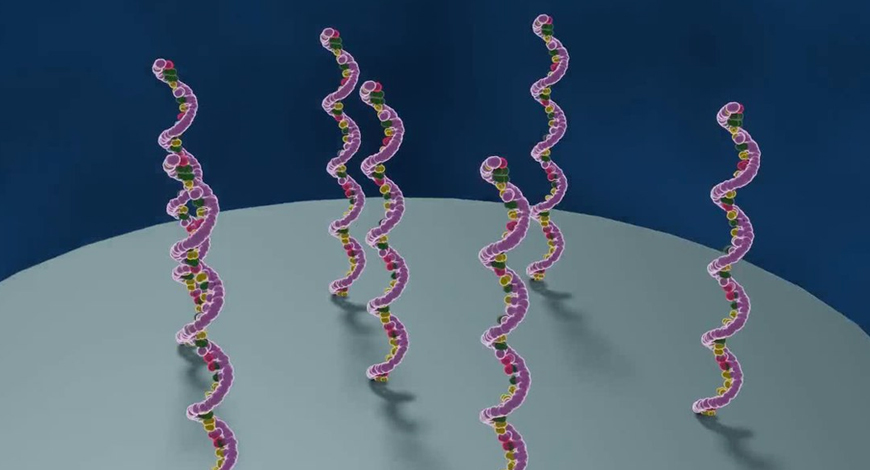Microarry Systems
Two-color array getting started

CMOS imaging sensors are emerging as an alternative to CCD imaging sensors, owing to their cost-efficient and low-power-consumption advantages. Stakeholders are carefully weighing the pros and cons of CCD and CMOS, whilst identifying how CCD is being used in demanding applications with the help of microarray scanners.
Novel technologies and state-of-the-art platforms developed and launched over the last two decades, such as microarrays, next-generation sequencing, and droplet PCR have provided the medical field many opportunities to generate and analyze big data from the human genome. The capability of microarrays to conduct a comprehensive and concurrent analysis of thousands of genes has resulted in the success of this technology in the last decade. Technological progression in computational capabilities and robotics for microarray procedures have steered the rapid uptake of gene chips in clinical laboratories worldwide. Vendors are striving to develop innovative solutions for storage and analysis of microarray-generated information to facilitate biomedicine applications of the array technology.
The industry is principally driven by a recent evolution in the areas of personalized medicine and cancer diagnostics. Many companies developing microarray technologies are catering to a vast majority of public institutes, which include government laboratories, academic centers, and clinical research organizations. Though the popularity of next-generation sequencing (NGS) has skyrocketed recently, it is not completely replacing microarrays in diagnostics and cytogenetics due to its relatively high price and sturdy rate of clinical implementation.
The global pandemic has increased the focus on the development of less time-consuming diagnostic kits along with the increased use of microarray techniques, which is likely to have a positive effect on the market.
SARS-CoV-2 is a betacoronavirus, which has led to the worldwide spread of the novel infection. Such trends have accelerated research and development (R&D) in the healthcare sector, including the microarray scanners market. GeneCopoeia – the largest provider of expression-ready clones – is publicizing its OmicsArray SARS-CoV-2 coronavirus antigen microarray, owing to its capability of multiplexing, high throughput, and high sensitivity.
The microarray scanner players are increasing their focus in gene expression and drug discovery to address the novel coronavirus infection. They are increasing the availability of antigen microarrays that help detect antibodies against SARSCoV- 2. Protein microarrays are also being preferred for powerful detection of antibodies associated with virus infections, including SARSCoV-2, SARS-CoV-1, and influenza.
The microarray scanner players are increasing their focus in gene expression and drug discovery to address the novel coronavirus infection. They are increasing the availability of antigen microarrays that help detect antibodies against SARS-CoV-2 and other pathogens. Protein microarrays are also being preferred for powerful detection of antibodies associated with virus infections, including SARS-CoV-2, SARS-CoV-1, and influenza, among others. Viral proteins are chosen based on a thorough review of peer-reviewed publications.
Emerging infectious diseases, with little-known mechanisms of infection and pathogenicity, represent a big challenge for stakeholders in the life sciences industry, research, and clinics. In order to overcome this challenge, companies in the microarray scanners market are providing dedicated glycan arrays to enhance research activities, and define precise mechanisms of virus and bacterial infection. Innopsys – a provider of cutting-edge instruments and software for research and diagnostics – is gaining recognition for its glycan arrays and high-density peptide arrays that are precious tools for understanding immune response, validating vaccines, and defining immunogenic epitomes.
The high-density peptide arrays hold promising potential in the discovery of host-pathogen interactions, pathogen epitopes, and patient immune responses that are essential for the development of new and preventive therapeutic approaches, such as for drugs and vaccines.
The global microarray scanners market size is estimated at USD 3.72 billion in 2020 and is expected to surpass USD 8.15 billion by 2030, expanding at a CAGR of 8.2 percent during 2021 to 2030. The microarray scanners market is predicted to surpass ~27,000 units by the end of 2030.
Companies in the microarray scanners market are entering into strategic partnerships to increase the availability of high-technology, solutions pertaining to innovative microarray platforms for viral infections screening and protein biomarkers analysis. This is being achieved with the help of near-infrared fluorescence, which explains why fluorescence microarray scanners are estimated to dominate the highest revenue among all product types in the market.
The R&D innovations in fluorescence microarray scanners hold promising potential in the protein biomarkers analysis with respect to zika, dengue, and SARS-CoV-2, among others. Proprietary gold-coated slides based on nanotechnology are being used in scanners. This technology deploys superior sensitivity and precision for the detection of sera antibodies developed by infected patients.
Factors, such as growing incidence of cancer worldwide, increasing expenditure on research and development in the healthcare sector, growing number of applications of microarrays, advances in the fields of proteomics and genomics, developments in bioinformatics, evolution of software, and increasing preference for DNA-based microarrays are driving the growth of microarray market. Moreover, growing applications of microarrays in the diagnosis of infectious and genetic diseases, drug discovery, and pharmacogenomics research, among others, is driving the microarray market growth across the world. Additional features that are expected to fuel this business are increasing requirement for new investigative approaches and technological innovations.
Owing to miniaturization, the LoC-based systems have shown to improve test speed, throughput, and cost-efficiency. In this direction, research toward developing new lab-on-a-chip-based POC systems for chronic diseases diagnosis is also fast growing into an emerging area.
Biochips are increasingly being used in the field of biomedical and biotechnological research. With the advancement of technology, there has been a rise in the adoption of biochips in proteomics, such as in microarrays. The advantages of protein biochips include the low sample consumption and its inclination toward miniaturization. These characteristics of microarrays are important for proteome-wide analysis. Proteomics is being widely adopted for biomarker and drug discoveries. Moreover, there is a rise in the demand for personalized medicine that is contributing to the growth of the market. However, other factors, such as the increasing use of biochips in cancer treatment and diagnostics, and rapid technological advances in biochip technology are driving the microarrays market.
Major players include Thermo Fisher Scientific, Agilent Technologies, Illumina, PerkinElmer, Roche, GE Healthcare, Molecular Devices (Danaher Corporation), Innopsys, and Berthold Technologies.
CCD versus CMOS imaging sensors – Which is better? Complementary metal-oxide semiconductor (CMOS) imaging sensors are emerging as an alternative to charge coupled device (CCD) image sensors, as CCD sensors consume increased power as compared to CMOS sensors. As such, CCD sensors help create high-quality and low-noise images, whereas CMOS sensors are usually more susceptible to noise.
On the other hand, CMOS sensors are much less expensive to manufacture than CCD sensors, and are rapidly improving performance. Such trends are likely to affect revenue generation in the microarray scanners market. Hence, companies in the market should fuel their manufacturing by increasing R&D in CMOS imaging sensors. As such, it has been found that CCD sensors are still required for certain demanding applications. Thus, device manufacturers should weigh the pros and cons of CCD image sensors to stay relevant to ongoing trends in the market.
Stakeholders in the microarray scanners market should consider weighing the pros and cons of CCD and CMOS, whilst identifying how CCD is being used in demanding applications with the help of microarray scanners. Companies in the microarray scanners market should enter into strategic partnerships to advance in near-infrared fluorescence, which helps in detection of sera antibodies developed by infected patients.
Selecting a microarray scanner. Microarray scanners are widely used in functional biology, cellomics, gene expression, and drug discovery research. When buying a microarray scanner, important features to consider are sensitivity, resolution, scan area, rapidity of scan, and ease of use. Microarray scanners usually have red, green, and blue excitation wavelengths and a wide choice of up to eight emission filters that enable imaging of an extensive variety of fluorophores (e.g., Cy3, Cy5, FITC, Texas Red). For high-volume use, features, such as a laser-saver (for programmable on/off according to workflow needs)m increase lifespan and reduce instrument maintenance. Depending on the application and funds available, one might choose a microarray scanner system with autofocus that continually adjusts to keep features in focus while scanning, confocal optics that allow for the sensitive detection of low-abundance targets, or automated multi fluorescence scanning that allows multiplexing.
 Dr Anita Joshi
Dr Anita Joshi
Founder,
Dr. Anita’s Bio Consultancy, Pune
“The human body comprises of thousands of genes and alteration in these genes results in disease. Often it becomes difficult for scientists and doctors to find the exact gene responsible for disease. Microarray technology is a powerful tool which efficiently investigates the expression of several genes simultaneously and this happens on a tiny slide called a gene chip. Genes that are fragmented into short, synthetic, single stranded DNA sequences are etched in an orderly array onto known locations on the glass slide, encased in a plastic cassette. These could belong to the same gene or to different genes. They are labelled with fluorescent dyes and are called probes. These help differentiate between normal and mutated genes. Further a highly specific hybridization reaction between known and unknown sequences happens upon adding the necessary reagents and gene fragments from a patient’s sample. Hybridization is based on the base pairing rules. Depending on which fragments are hybridized, it is possible to identify the disease causing genes. Initially this technique was used only in research, but today the technology has evolved and used widely in diagnostics. Demand is on the rise and the market size is expected to be 7.4 billion USD by 2026.
Overall, although the word limitation still floats around, and with only 5 percent of novel molecular compounds are ultimately selected to enter the drug and therapeutic marketplace, new innovations in science and technology are critical in the arena of drug discovery and therapeutics. It is these ongoing research advances and technological innovations that will empower scientists to continue on in the pursuit of additional and more sophisticated, reliable, and efficient molecular tools, such as microarrays, that will be useful in the arena of drug discovery and therapeutics. These efforts, innovations, and technologies will undoubtedly continue to revolutionize the healthcare industry that will aid in identifying better and more effective drugs, at much lower costs, and within shorter periods of time.












